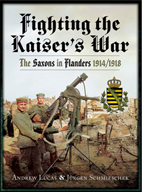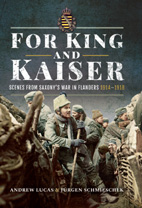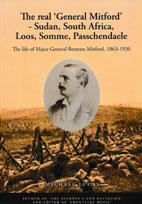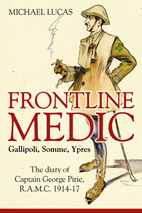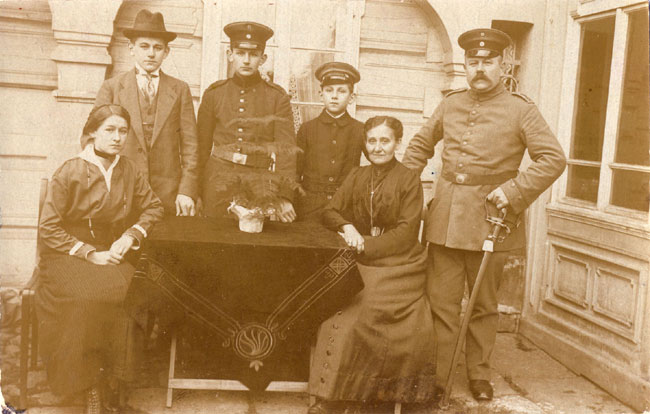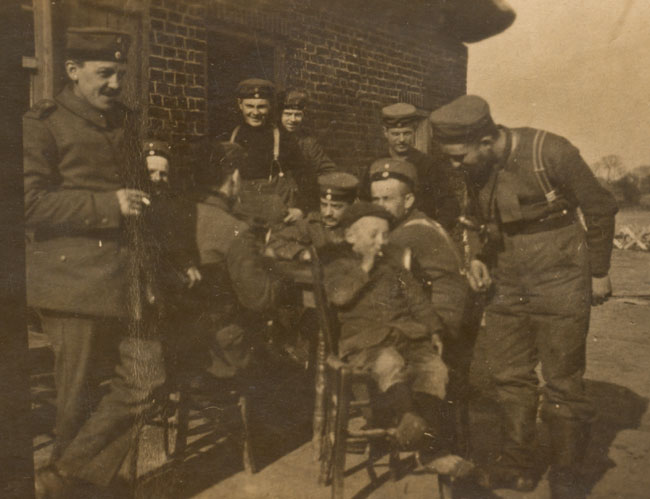At the beginning of the war, under-aged members of approved youth organisations such as the Pfadfinder (the German branch of the Boy Scouts) had been permitted to volunteer for non-combatant service with parental permission. Their official role was to act as messengers in the rear area and at higher headquarters, where they could make themselves useful at a suitable distance from the fighting. In practice some of these boys managed to get considerably further forward than they were supposed to, and were tolerated or even praised for their daring. Fritz Lehmann was one of them, and seems to have briefly become a celebrity of sorts.
Above: An unknown Saxon family during the war. The father wears the Feldgrau uniform of FAR 64 (a field artillery regiment garrisoned in Pirna). One of his sons wears the pre-war 'colourful' (for the infantry, dark blue with red facings) uniform of IR 179, indicating service with one of its Ersatz-Bataillonen in Leisnig or Wurzen - a surprising choice, as those towns are halfway across Saxony from the home of his father's regiment.
The youngest son proudly sports his uniform cap from the local Jugendwehr. These loosely coordinated local youth groups provided pre-military training, which during the war took on an increasingly serious and organised character under direct military supervision.
The book Nacht über Europa: Kulturgeschichte des Ersten Weltkrieges by Ernst Piper cites an article in the Berlin newspaper Der Tag dated 12th November 1914, approvingly reporting the recommendations of the fourteen-year-old Karl Belz from Tegel and the "fifteen-year-old" Fritz Lehmann from Leipzig for the Iron Cross. Belz had served in his Pfadfinder uniform with an artillery detachment, so probably not in the literal front line. Lehmann however had been (lightly) wounded with XII. Armeekorps at the horrific and bloody battle of Dinant in August, after which he apparently returned home. There is no corresponding Verlustliste entry, presumably because of his non-military status. The attached picture postcard shows Lehmann in his Pfadfinder uniform at (presumably) the conclusion of this first outing, sporting a bandaged hand. It is the only image of him we have been able to find, and the only source for his birthday - 4th January 1900, making him fourteen at the time.
Despite having "scarcely recovered" from his wound, Der Tag states that Fritz Lehmann soon returned to the front and "rescued a wounded major". Evidently he had managed to accompany RIR 245 when it left Leipzig in October for the battlefront east of Ypres, where he met Major von Heygendorff. Sadly we have been unable to find any further mention of him, or any corroboration of the incident involving the "wounded major" - certainly not von Heygendorff, who came through the First Battle of Ypres unscathed.
Although Lehmann himself is not mentioned, a reader's letter published in the post-war regimental veterans' newsletter 'Was wir erlebten – 245er Erinnerungen' unexpectedly reveals that he was not the only underage runaway to accompany the regiment into the field that autumn. The writer, one Max Seifert, describes the situation within his own company (7.) and battalion (II.); we can only assume that Lehmann (and perhaps others as yet unnamed) stowed away with the I. or III. Bataillon. Seifert was evidently responding to an article by one of these irregular volunteers which had appeared in a previous issue - sadly we have not located a copy of what was clearly a very colourful piece!
Above: Children inevitably grew up quickly in occupied Belgium. This (presumably) Flemish civilian boy smokes with apparent relish, much to the amusement of these Saxon infantrymen from RIR 241.
War Volunteers - Fact and Fiction
By Max Seifert, Leipzig, 7./245
In issue Nr.12/36 of '245er Erinnerungen' an article was printed under the title "Kriegsfreiwilliger Schuffenhauer" which must not go unchallenged. Its contents are not consistent with the facts. I would like to adduce the following by way of correction:
When RIR 245 set out into the field on 12th October 1914, there emerged among the II. Bataillon and in particular among the 7. Kompanie four young thrill-seekers aged 15-16, who had embarked with us unchallenged and now raced with us toward the great experience. For two of them their outward journey went awry only too soon. In Werdau, where we stopped and were fed for the first time, inquiry after the runaways was received, specifically from the parents in Leipzig. As a result the train was searched for them, with two of them being caught and taken home. The other two, however, with advance knowledge and the assistance of comrades stowed themselves away in the lavatory, so that they managed to reach the front with us. It was the Schuffenhauer mentioned in the article and a certain Kümmelberg from Schenkendorffstraße [in Leipzig]. At that time we were living in abundance. So the two youngsters didn't have to starve.
When we were unloaded in Leuze and immediately began the advance, they continued to stroll along with us at our side. They also disappeared now and again for a day until positional [trench] warfare set in. Then above all it was Schuffenhauer who soon branched out on his own. Somehow and somewhere he had found himself a cart and a horse, and now he was driving around behind the lines. Here he helped himself to something, there he sold something. Then he faded away for a while. At the end of December 1914 he reappeared once again with the 7. Kompanie. He proudly wore the Iron Cross 2nd Class, which by his own assertion had been pinned to him by the exalted hand of General Kluck himself. He was able to report everything which he had experienced in the meantime. He had apparently lived a real vagabond life during his absence. - Kümmelberg tended to stick with the [field] kitchen, where he was happy to spend his time when he too was not off 'on tour' for a few days like his contemporary Schuffenhauer.
At the end of January 1915, Major von Heygendorff put a sudden end to this idyll. Both were unceremoniously packed off home. What then became of Schuffenhauer is beyond my knowledge. What I reported is true, everything else is made up out of thin air. Both boys were adventurous characters who took part in the war in their own way.
(Editorial note: what would comrade Seifert say about the content of the manuscript penned by Schuffenhauer, if he clapped eyes on him?)
I strongly suspect that Major von Heygendorff must have sent "my friend Lehmann" home at the same time as the others. Sadly we do not have his own account of this regimental crackdown at the end of January 1915.

